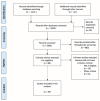The True Impact of Voiding Dysfunctions after Transobturator Sub-Urethral Tape Procedures: A Systematic Review of Literature
- PMID: 39200904
- PMCID: PMC11355201
- DOI: 10.3390/jcm13164762
The True Impact of Voiding Dysfunctions after Transobturator Sub-Urethral Tape Procedures: A Systematic Review of Literature
Abstract
Introduction: Transobturator techniques are frequently used for the surgical treatment of female stress urinary incontinence (SUI), due to their high success rates and few intraoperative complications. However, controversial results have been reported in the literature regarding their incidence. The aim of this study is to analyze the real incidence and trend over time of such complications, especially voiding dysfunctions and overactive bladder (OAB) symptoms. Methods: A comprehensive search using PubMed/MEDLINE, Scopus, and Cochrane databases was performed. The search string used was the following: (female stress urinary incontinence) AND (complication) AND ((midurethral sling) OR (transobturator tape) OR (TVT-O) OR (voiding dysfunctions) OR (de novo OAB) OR (recurrent UTI) OR (vaginal erosion)). We included randomized controlled trials, prospective controlled studies, prospective and retrospective observational studies. All selected articles were screened based on titles and abstracts. Relevant data were extracted and tabulated. Results: A total of 39 studies were included in our analysis. Transobturator tape procedures show a high objective cure rate for SUI, from 76.9% to 100%. Postoperative voiding dysfunctions are shown to be quite common, ranging from 0-22% of cases. Despite that, this percentage decreases to 0-1% after 12 months. De novo OAB incidence ranges from 3% to 14% at 12 months, with variability over time due to multiple factors. Tape-related complications usually occur after 12 months, with a variable incidence up to 7%. Urinary tract infections (UTIs) are quite common in the immediate postoperative period but sometimes can be recurrent, requiring long-term prophylactic antibiotic treatment. Conclusions: Voiding dysfunctions are generally transient complications, while de novo OAB may persist over time. An adequate preoperative counseling, along with accurate written informed consent, could enhance patient tolerance of these issues and contribute to long-term patient satisfaction.
Keywords: TOT; TVT-O; de novo OAB; transobturator tape; urinary tract infections; voiding dysfunctions.
Conflict of interest statement
The authors declare no conflict of interest.
Similar articles
-
Meta-analysis of female stress urinary incontinence treatments with adjustable single-incision mini-slings and transobturator tension-free vaginal tape surgeries.BMC Urol. 2015 Jul 7;15:64. doi: 10.1186/s12894-015-0060-3. BMC Urol. 2015. PMID: 26148987 Free PMC article. Review.
-
Midurethral slings for women with stress urinary incontinence: an evidence-based analysis.Ont Health Technol Assess Ser. 2006;6(3):1-61. Epub 2006 Feb 1. Ont Health Technol Assess Ser. 2006. PMID: 23074494 Free PMC article.
-
Effectiveness of retropubic tension-free vaginal tape and transobturator inside-out tape procedures in women with overactive bladder and stress urinary incontinence.Int Neurourol J. 2013 Sep;17(3):145-51. doi: 10.5213/inj.2013.17.3.145. Epub 2013 Sep 30. Int Neurourol J. 2013. PMID: 24143294 Free PMC article.
-
Retropubic tension-free vaginal tape and inside-out transobturator tape: a long-term randomized trial.Int Urogynecol J. 2016 Jan;27(1):103-11. doi: 10.1007/s00192-015-2798-2. Epub 2015 Aug 12. Int Urogynecol J. 2016. PMID: 26264474 Clinical Trial.
-
[Bladder injury during sling operation in the treatment of SUI--review of literature and case report].Ginekol Pol. 2012 Oct;83(10):784-8. Ginekol Pol. 2012. PMID: 23383566 Review. Polish.
References
-
- D’Ancona C., Haylen B., Oelke M., Abranches-Monteiro L., Arnold E., Goldman H., Hamid R., Homma Y., Marcelissen T., Rademakers K., et al. The International Continence Society (ICS) report on the terminology for adult male lower urinary tract and pelvic floor symptoms and dysfunction. Neurourol. Urodyn. 2019;38:433–477. doi: 10.1002/nau.23897. - DOI - PubMed
Publication types
LinkOut - more resources
Full Text Sources


